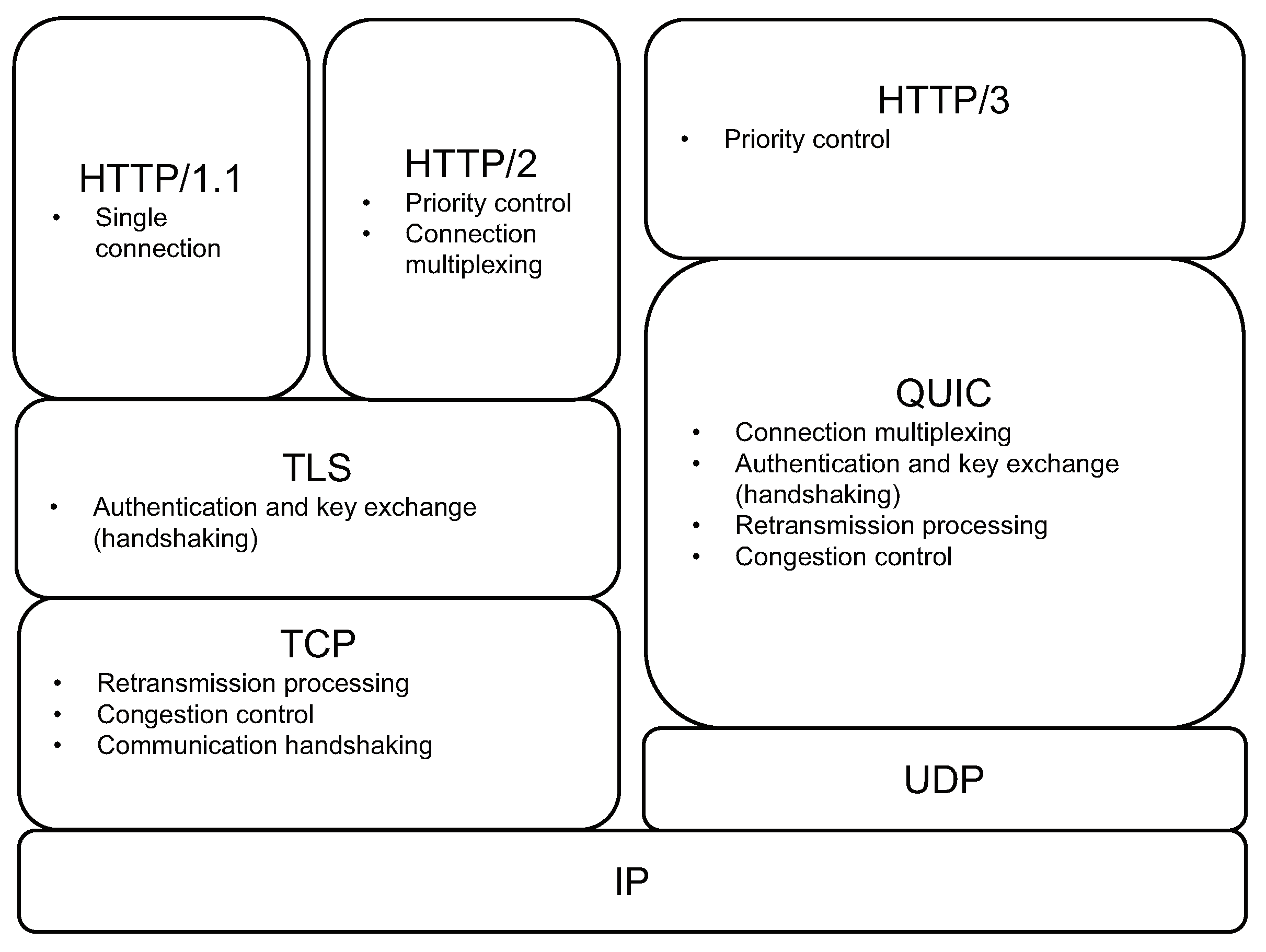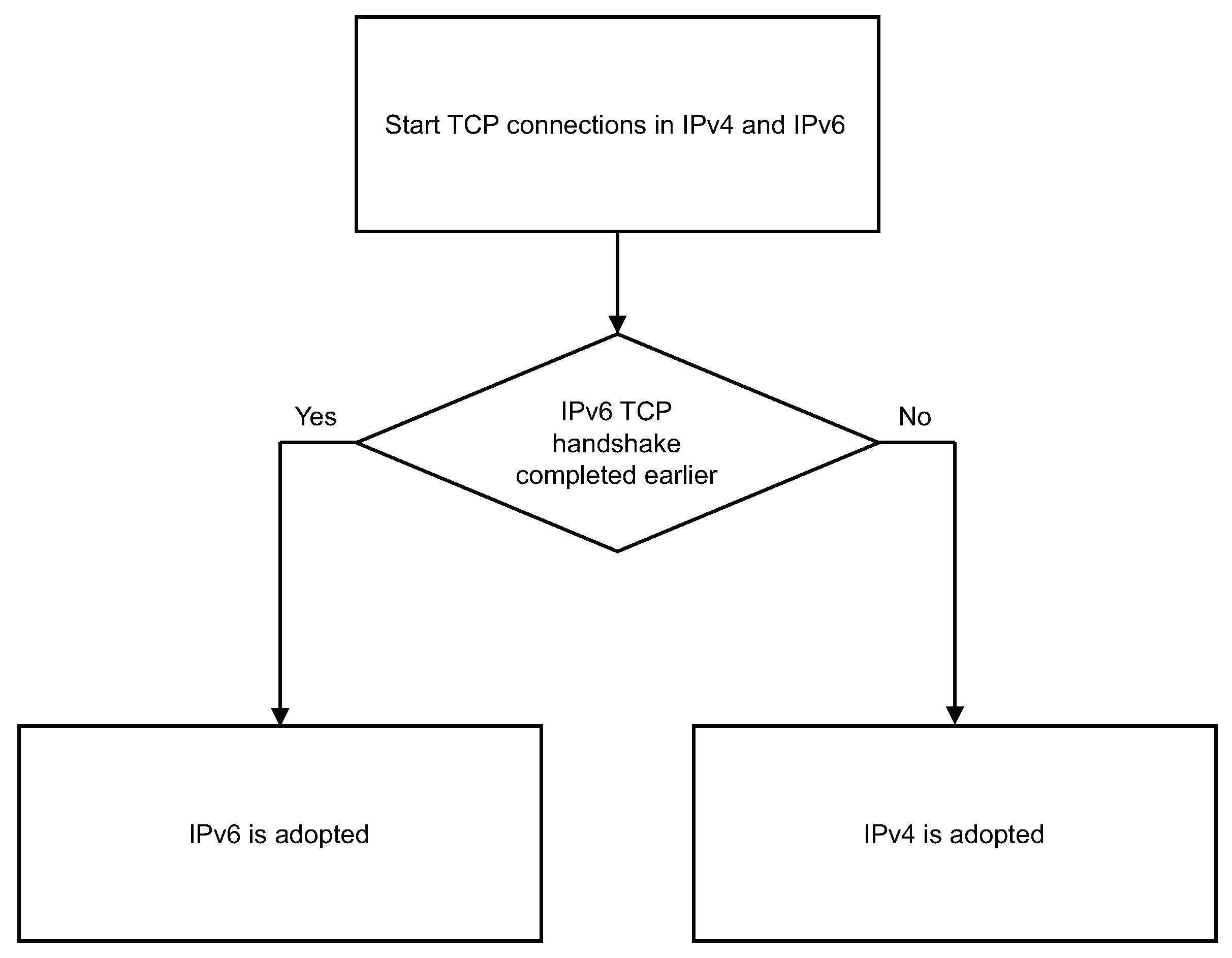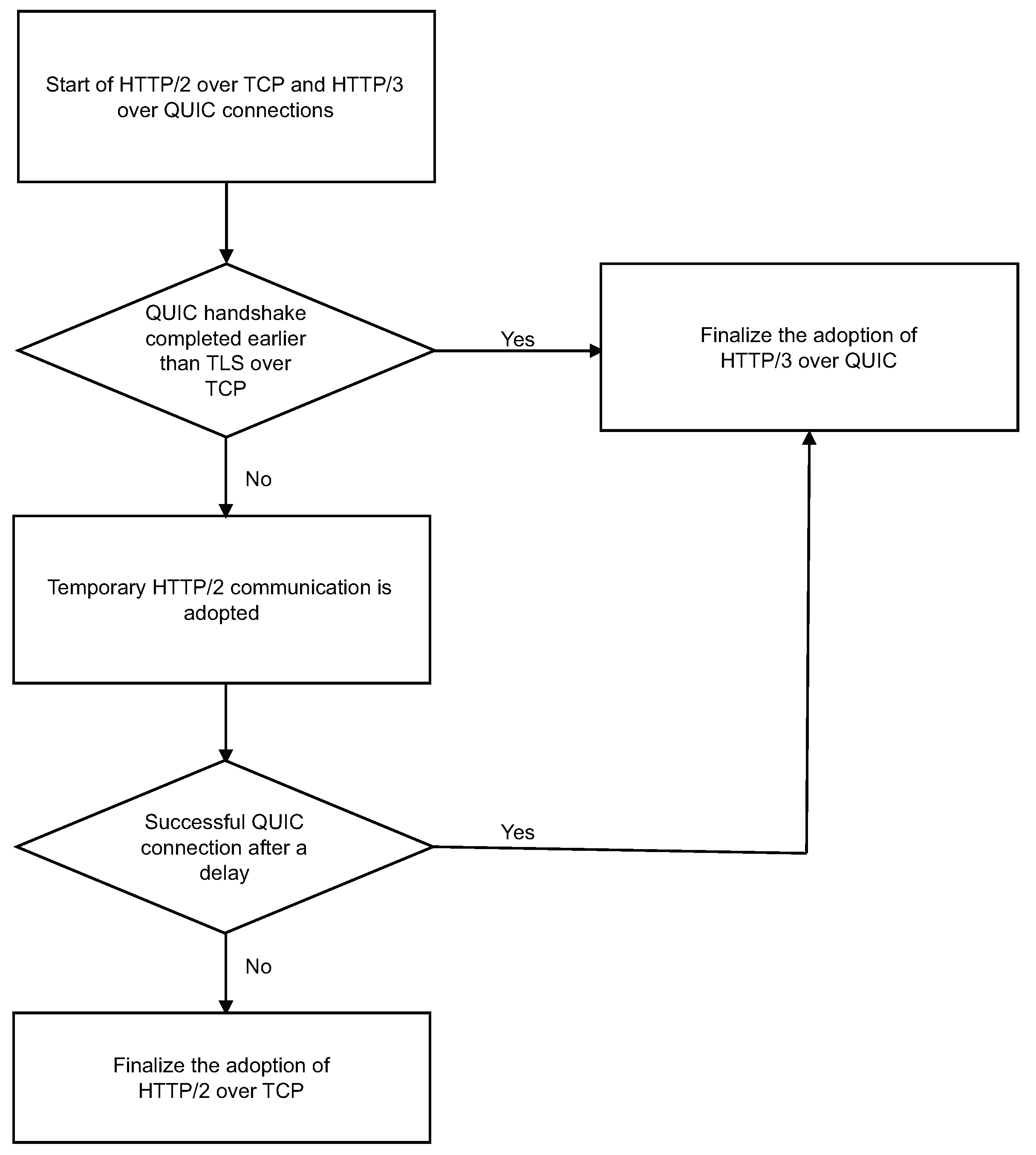Implementation and Evaluation of HTTP/3 Connectivity Check Using Happy Eyeballs Algorithm
Abstract
:1. Introduction
2. Related Works
2.1. QUIC and HTTP/3
2.2. Current Connectivity Verification Method: Alt-Svc
- The client makes an HTTP request using the old protocol.
- The server sets the corresponding protocol version, address, etc. in the “Alt-Svc” field (The “Alt-Svc” field may contain cache information, in which case the client uses it based on the given expiration date, unless it detects a change in the network configuration) of the response header and sends the request using the old protocol.
- The client sends the HTTP request using the new protocol from the next request based on the information obtained from the “Alt-Svc” field.
2.3. Happy Eyeballs
3. Proposed Method
4. Implementation and Experimental Results
4.1. Implementation
4.2. Experimental Methods
- We measured the HTTP/3 adoption rate and connection establishment time using the proposed method in an environment without intentional failures.
- External delay and packet loss were set separately, and the changes in these metrics were observed.
- As a comparison experiment, we measured the connection establishment time in Alt-Svc. However, for a fair and clear evaluation, only the first request was repeatedly measured from the state in which no connection was established for both cases. (We did not measure whether HTTP/3 was adopted in the second and subsequent communications.)
4.3. Results of External Delay Setting
4.4. Results of Packet Loss Setting
5. Discussion
6. Conclusions
Author Contributions
Funding
Institutional Review Board Statement
Informed Consent Statement
Data Availability Statement
Conflicts of Interest
References
- Iyengar, J.; Thomson, M. QUIC: A UDP-Based Multiplexed and Secure Transport; IETF RFC 9000; Internet Engineering Task Force: Washington, DC, USA, 2021. [Google Scholar]
- Usage Statistics of HTTP/3 for Websites. Available online: https://w3techs.com/technologies/details/ce-http3 (accessed on 10 May 2022).
- Thomson, M.; Benfield, C. Hypertext Transfer Protocol Version 3 (HTTP/3); IETF RFC 9113; Internet Engineering Task Force: Washington, DC, USA, 2022. [Google Scholar]
- Nottingham, M.; McManus, P.; Reschke, J. HTTP Alternative Services; IETF RFC 7838; Internet Engineering Task Force: Washington, DC, USA, 2016. [Google Scholar]
- Postel, J. User Datagram Protocol; IETF RFC 768; Internet Engineering Task Force: Washington, DC, USA, 1980. [Google Scholar]
- Postel, J. Transmission Control Protocol; IETF RFC 793; Internet Engineering Task Force: Washington, DC, USA, 1981. [Google Scholar]
- Rescorla, E. The Transport Layer Security (TLS) Protocol Version 1.3; IETF RFC 8446; Internet Engineering Task Force: Washington, DC, USA, 2018. [Google Scholar]
- Belshe, M.; Peon, R.; Thomson, M. Hypertext Transfer Protocol Version 2 (HTTP/2); IETF RFC 7540; Internet Engineering Task Force: Washington, DC, USA, 2015. [Google Scholar]
- Langley, A.; Riddoch, A.; Wilk, A.; Vicente, A.; Krasic, C.; Zhang, D.; Yang, F.; Kouranov, F.; Swett, I.; Iyengar, J.; et al. The QUIC Transport Protocol: Design and Internet-Scale Deployment. In Proceedings of the Conference of the ACM Special Interest Group on Data Communication (ACM SIGCOMM ’17), Los Angeles, CA, USA, 21–25 August 2017; pp. 183–196. [Google Scholar] [CrossRef] [Green Version]
- Wing, D.; Yourtchenko, A. Happy Eyeballs: Success with Dual-Stack Hosts; IETF RFC 6555; Internet Engineering Task Force: Washington, DC, USA, 2012. [Google Scholar]
- Schinazi, D.; Pauly, T. Happy Eyeballs Version 2: Better Connectivity Using Concurrency; IETF RFC 8305; Internet Engineering Task Force: Washington, DC, USA, 2017. [Google Scholar]
- Bajpai, V.; Schönwälder, J. Measuring the Effects of Happy Eyeballs. In Proceedings of the 2016 Applied Networking Research Workshop, Berlin, Germany, 16 July 2016; pp. 38–41. [Google Scholar] [CrossRef]
- Berners-Lee, T.; Fielding, R.; Masinter, L. Uniform Resource Identifier (URI): Generic Syntax; IETF RFC 3986; Internet Engineering Task Force: Washington, DC, USA, 2005. [Google Scholar]
- Iyengar, S. Moving fast at scale: Experience deploying IETF QUIC at Facebook. In Proceedings of the Workshop on the Evolution, Performance, and Interoperability of QUIC (EPIQ’18), Heraklion, Greece, 4 December 2018; ACM: New York, NY, USA, 2018. [Google Scholar] [CrossRef]
- Schwartz, B.; Bishop, M.; Nygren, E. Service Binding and Parameter Specification via the DNS (DNS SVCB and HTTPS RRs); IETF draft-ietf-dnsop-svcb-https-09; Internet Engineering Task Force: Washington, DC, USA, 2022. [Google Scholar]



| Delay (ms) | Adoption Rate (%) | Avg. Time (ms) | (ms) |
|---|---|---|---|
| 0 | 99.7 | 3.2 | 1.4 |
| 50 | 100.0 | 57.4 | 4.4 |
| 100 | 100.0 | 108.2 | 2.7 |
| 150 | 100.0 | 158.4 | 2.8 |
| 200 | 100.0 | 208.4 | 4.6 |
| Delay (ms) | Avg. Time (ms) | (ms) |
|---|---|---|
| 0 | 2.1 | 0.8 |
| 50 | 109.9 | 4.9 |
| 100 | 209.6 | 3.9 |
| 150 | 310.4 | 3.2 |
| 200 | 410.5 | 7.4 |
| Loss Rate (%) | Adoption Rate (%) | Avg. Time (ms) | (ms) | Max. Time (ms) |
|---|---|---|---|---|
| 0 | 99.7 | 3.2 | 1.4 | 20 |
| 3 | 96.4 | 4.8 | 32.4 | 1005 |
| 10 | 91.0 | 18.5 | 110.2 | 1079 |
| 25 | 78.0 | 79.3 | 278.0 | 3115 |
| 50 | 62.7 | 474.0 | 975.0 | 15,475 |
| Loss Rate (%) | Avg. Time (ms) | (ms) | Max. Time (ms) |
|---|---|---|---|
| 0 | 2.1 | 0.8 | 18 |
| 3 | 36.8 | 173.1 | 1073 |
| 10 | 120.6 | 310.2 | 3079 |
| 25 | 374.0 | 675.9 | 7125 |
Publisher’s Note: MDPI stays neutral with regard to jurisdictional claims in published maps and institutional affiliations. |
© 2022 by the authors. Licensee MDPI, Basel, Switzerland. This article is an open access article distributed under the terms and conditions of the Creative Commons Attribution (CC BY) license (https://creativecommons.org/licenses/by/4.0/).
Share and Cite
Matsuzawa, T.; Ichikawa, K. Implementation and Evaluation of HTTP/3 Connectivity Check Using Happy Eyeballs Algorithm. Network 2022, 2, 389-397. https://doi.org/10.3390/network2030024
Matsuzawa T, Ichikawa K. Implementation and Evaluation of HTTP/3 Connectivity Check Using Happy Eyeballs Algorithm. Network. 2022; 2(3):389-397. https://doi.org/10.3390/network2030024
Chicago/Turabian StyleMatsuzawa, Tomofumi, and Kyosuke Ichikawa. 2022. "Implementation and Evaluation of HTTP/3 Connectivity Check Using Happy Eyeballs Algorithm" Network 2, no. 3: 389-397. https://doi.org/10.3390/network2030024
APA StyleMatsuzawa, T., & Ichikawa, K. (2022). Implementation and Evaluation of HTTP/3 Connectivity Check Using Happy Eyeballs Algorithm. Network, 2(3), 389-397. https://doi.org/10.3390/network2030024







